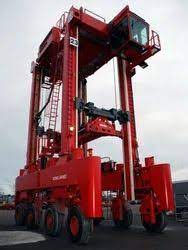
STRADDLE CARRIER
A Straddle Carrier is a specialized mobile vehicle or lifting machine used in ports, container yards, and logistics facilities for the transportation and stacking of shipping containers. It's characterized by its unique design, which allows it to straddle containers and lift them off the ground for efficient handling and transport.
Product Feature
1. Straddling Design: Straddle carriers have a distinctive design with long legs that can straddle the width of a standard shipping container, providing stability during lifting and transportation.
2. Container Handling: They are equipped with a lifting mechanism (usually spreader bars or telescopic arms) to securely lift and stack containers.
3. Maneuverability: Straddle carriers can move in multiple directions, including forward, backward, and sideways, allowing for precise container placement.
4. Adjustable Spreaders: The spreader bars or arms can often be adjusted to accommodate containers of various sizes and types, including standard ISO containers and specialized containers.
5. Operator Cab: Straddle carriers typically have an operator cab that provides a clear view of the containers and the surrounding area for safe and efficient operation.
6. Telematics: Many modern straddle carriers are equipped with telematics systems for remote monitoring, maintenance scheduling, and performance optimization.
Product Application
1. Efficient Container Handling: Straddle carriers are highly efficient for moving and stacking containers, allowing for quick loading and unloading of ships and efficient container storage.
2. Versatility: They can handle a variety of container sizes and types, making them suitable for diverse cargo operations.
3. Minimized Ground Pressure: The straddling design distributes the weight of the carrier and the container, reducing the ground pressure and minimizing damage to the terminal surface.
4. Space Optimization: Straddle carriers can stack containers in tight spaces, maximizing the use of storage areas in container yards.
5. Reduced Labor Costs: Automation and efficient handling reduce the need for manual labor, leading to cost savings and improved safety.
6. Increased Throughput: They contribute to faster turnaround times for vessels, improving the overall efficiency of container terminals and logistics operations.
7. Safety: Straddle carriers are designed with safety features to protect both operators and cargo during handling operations.
8. Environmental Benefits: Some straddle carriers are equipped with eco-friendly features, such as hybrid or electric power options, reducing emissions and energy consumption.




